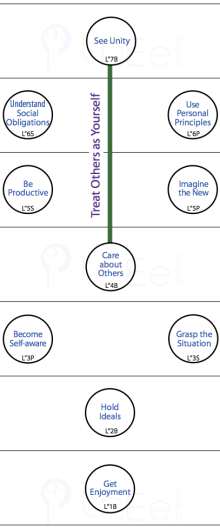Form – Storm – Norm – Perform
During the final reviews of this framework, I realized that it parallels a well-known model of group development generated by Bruce Tuckman![]() . His 1965 model synthesized findings from several traditions of group work. However, it was oriented to groups pursuing a challenging project that required leadership, planning and cooperation.
. His 1965 model synthesized findings from several traditions of group work. However, it was oriented to groups pursuing a challenging project that required leadership, planning and cooperation.
The present framework is also built around a project, but it is a one person (or «first person») project: you have to for yourself and others. It seems likely that this framework is the deep source of Tuckman's model. A comparison of his four Stages below provides some evidence for this view.

Forming
Group Characteristic: The requirement here is a general orientation, with unification of members based on commitment to the mission of the group. All members are expected to accept each other. Typically they do: it is a honeymoon period of good feelings.
Taxonomic Correspondence: Unite with others. See image at right.
Difference: As it is about my life in my social milieu, there is no special leadership role, no defined end result, and no possibility to exit—except for another milieu where identical issues apply.

Storming
Group Characteristic: The requirement here is to cope with the differences amongst members. These differences of perspectives, abilities and attitudes are essential to maximize success. However, in the early stages they create heated disputes, confrontations, and resistance to all efforts towards constructive progress. It is essential to recognize that all members have a part to play in a successful outcome. Members often feel dissatisfied, confused and frustrated until they sense their role.
Taxonomic Correspondence: Stabilize myself. See image at left.
Difference: In my social milieu, there is never a definitive resolution. I have to continuously deal with my work issues, get private comfort, and handle public interactions and moral issues. Continuous change means a degree of turmoil is unavoidable and regular readjustments are required using the relevant Precepts.
Norming

Group Characteristic: Intense involvement develops. Implicit and explicit plans, rules and values emerge and are adopted. Everybody recognizes what tasks are required and how they are to be pursued as a group. Feedback and collaboration support cohesion and morale. There is a willingness to contribute positively and work diligently.
Taxonomic Correspondence: Thrive with others. See image at right.
Difference: The undirected social world, of which I am a part, develops values, ideologies, institutions and projects that are both unifying and differentiating. The only goal that can unite all is the flourishing of each member and the betterment of the social world generally. To pursue this, I must adhere to Precepts that emerge from combining a focus on «getting a grip» with those based on «paying attention».
Performing

Group Characteristic: There is an established interdependence between the members and the group. The group generates a flow of achievements based on collaborative work of members to meet existing and emerging challenges.
Taxonomic Correspondence: Assert myself. See image at left.
Difference: The focus is back on me because the social milieu is subject to collective forces that are not always rational and compassionate. The challenge is then evident and I must «rise to the occasion» and play a small part in producing change in myself &/or my surroundings.
If any world is to improve, then every person must be ready individually, on occasion, to do three things. You must and confront group customs and laws that are unjust or inhuman; to make your mark on social life; and when you, others, or the collective are self-deceiving.
- Back to issues for review.
Originally posted: 15-Feb-2013